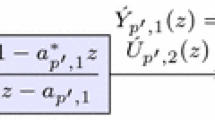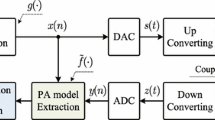Abstract
This paper presents a new time-domain model of radio frequency power amplifiers (RFPA) for wideband applications. The proposed model identification requires a set of characterization procedures of a memory polynomial model with delay taps for a two-tone test. This first characterized model is described using amplitude AM/AM and phase AM/PM characteristics including delay and gain parameters, which is able to reproduce distortion sideband asymmetries. A two-tone signal with varying tone spacings is used to find the frequency response of parameters on each nonlinearity order. These response are used to estimate equivalent digital filters giving the final structure of a wideband model. The measurement tests on a Class AB −1.85 GHz RFPA from advanced semiconductor business with various multitone signals show that the proposed architecture describes PA nonlinearities and memory effects with a high level of accuracy.












Similar content being viewed by others
Notes
The nonlinear model of the transistor is referenced librairie MW6S010NR1 ADS Product Model Design Kit available at http://www.freescale.com, register and follow links : Freescale/Products/RF/RF Power/Transistors: Cellular—to 1000 MHz/MW6S010N/Software & Tools/RF High-Power Models.
References
Ku, H., Mckinley, M., & Kenney, J. (2002). Quantifying memory effects in rf power amplifiers. IEEE Transactions on Microwave Theory and Techniques, 50(12), 2843–2849.
Bohara, V. A., & Ting, S. H. (2008). Analysis of ofdm signals in nonlinear high power amplifier with memory (pp.3653–3657).
Ngoya, E., Quindroit, C., & Nebus, J. (2009). On the continuous-time model for nonlinear-memory modeling of rf power amplifiers. IEEE Transactions on Microwave Theory and Techniques, 57(12), 3278–3292.
Cripps, S. (1999). Rf power amplifiers for wireless communications., Artech House Microwave Library Boston: Artech House.
Vuolevi, J., Rahkonen, T., & Manninen, J. (2001). Measurement technique for characterizing memory effects in rf power amplifiers. IEEE Transactions on Microwave Theory and Techniques, 49(8), 1383–1389.
Williams, D., Leckey, J., & Tasker, P. (2002). A study of the effect of envelope impedance on intermodulation asymmetry using a two-tone time domain measurement system. In IEEE MTT-S International Microwave Symposium Digest, vol. 3 (pp.1841–1844).
de Carvalho, N., & Pedro, J. (2002). A comprehensive explanation of distortion sideband asymmetries. IEEE Transactions on Microwave Theory and Techniques, 50(9), 2090–2101.
Boumaiza, S., & Ghannouchi, F. (2003). Thermal memory effects modeling and compensation in rf power amplifiers and predistortion linearizers. IEEE Transactions on Microwave Theory and Techniques, 51(12), 2427–2433.
Golestaneh, H., Abdipour, A., & Mohammadi, A. (2012). Nonlinear modeling and analysis of a doherty power amplifier driven by non-constant envelope signals. Analog Integrated Circuits and Signal Processing, 72(1), 141–153.
Vuolevi, J., & Rahkonen, T. (2003). Distortion in Rf power amplifiers., Artech House Microwave Library Boston: Artech House.
Duvanaud, C., Robin, F., Dardenne, S., Huin, F., & Dascalescu, L. (2005). Effects of low-frequency drain termination and injection on nonlinear amplifier performances, 15(2), 231–240.
Cripps, S. C. (2002). Advanced techniques in RF power amplifier design. Boston: Artech House.
Kenney, J. S., Woo, W., Ding, L., Raich, R., Ku, H., & Zhou, T. G. (2001). The impact of memory effects on predistortion linearization of rf power amplifiers. In 8th International Symposium on Microwave and Optical Technology (pp. 189–193).
Ku, H., & Kenney, J. (2003). Behavioral modeling of nonlinear rf power amplifiers considering memory effects. IEEE Transactions on Microwave Theory and Techniques, 51(12), 2495–2504.
Ahmed, A., Abdalla, M., Mengistu, E., & Kompa, G. (2004). Power amplifier modeling using memory polynomial with non-uniform delay taps. In 34th European Microwave Conference, vol. 3 (pp.1457–1460).
Calinoiu, N., Bachir, S., & Duvanaud, C. (2011). A power amplifier envelope distortion model using direct calculation of polynomial parameters and delay taps. In European Microwave Integrated Circuits Conference (EuMIC), (pp.292–295).
Calinoiu, N., Bachir, S., & Duvanaud, C. (2013). From narrowband to wideband modeling of radio frequency power amplifiers. In IEEE 11th International New Circuits and Systems Conference (NEWCAS), (pp.1–4).
Ljung, L. (1999). System identification: Theory for the user. Englewood Cliffs: Prentice Hall.
Kouril, F., & Vrba, K. (1988). Non-linear and parametric circuits: principles, theory and applications. Chichester: Ellis Horwood.
Suchanek, P., & Haasz, V. (2007). Approaches to the adc transfer function modelling. In 12th International Workshop on ADC Modeling and testing (pp.127–130). IMEKO-IWADC: Iasi CERMI Publishing House
Gustavsen, B., & Semlyen, A. (1999). Rational approximation of frequency domain responses by vector fitting. IEEE Transactions on Power Delivery, 14(3), 1052–1061.
Parks, T., & Burrus, C. (1987). Digital filter design. New York: John Wiley & Sons.
Mekonnen, Y., & Schutt-Aine, J. (2007). Broadband macromodeling of sampled frequency data using z-domain vector-fitting method. In IEEE Workshop on Signal Propagation on Interconnects. SPI 2007, (pp.45–48).
Pintelon, R., & Schoukens, J. (2001). System identification: A frequency domain approach. New York: Wiley-IEEE Press.
Kim, J., & Konstantinou, K. (2001). Digital predistortion of wideband signals based on power amplifier model with memory. Electronics Letters, 37(23), 1417–1418.
Ding, L., & Zhou, G. (2004). Effects of even-order nonlinear terms on power amplifier modeling and predistortion linearization. IEEE Transactions on Vehicular Technology, 53(1), 156–162.
Author information
Authors and Affiliations
Corresponding author
Rights and permissions
About this article
Cite this article
Bachir, S., Calinoiu, N.E. & Duvanaud, C. New RF power amplifiers modeling and identification for wideband applications. Analog Integr Circ Sig Process 83, 161–172 (2015). https://doi.org/10.1007/s10470-015-0519-x
Received:
Revised:
Accepted:
Published:
Issue Date:
DOI: https://doi.org/10.1007/s10470-015-0519-x




